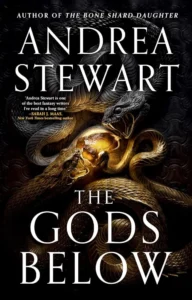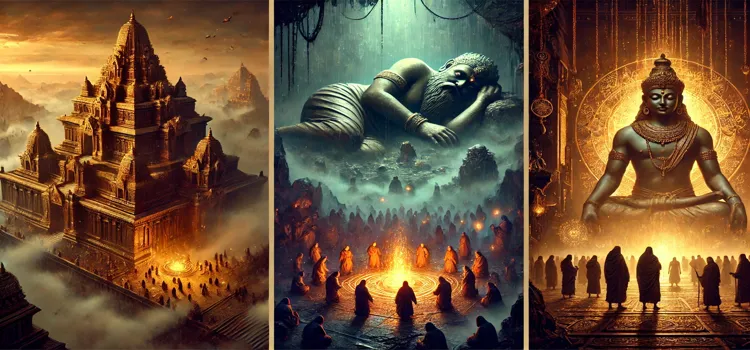The Gods Below, Andrea Stewart
Andrea Stewart’s The Gods Below is a captivating fantasy novel that blends ancient mythology with political intrigue, all set in a richly imagined world where gods slumber beneath the earth. This review delves into the complex characters and themes of power, faith, and humanity’s struggle with divine forces.
As a devoted fan of both fantasy and intricate world-building, I was excited to dive into The Gods Below by Andrea Stewart. Stewart has already proven her skills with her debut The Bone Shard Daughter, and with The Gods Below, she elevates her storytelling even further, blending elements of ancient mythology, political intrigue, and an exploration of humanity’s place in a world dominated by deities. What begins as a gripping adventure quickly becomes an exploration of power, control, and the moral consequences of seeking to harness the divine.

Plot Overview
The Gods Below is set in a sprawling world where gods don’t just watch humanity; they live beneath the earth, influencing life. For centuries, these gods have slumbered underground, their presence both revered and feared by the people of the Seven Nations. The novel begins with the awakening of a god, a cataclysmic event that disrupts the kingdoms and puts Lira at the center.
Lira, a former priestess of the God Below, is one of few humans who lived near the divine power underground. After leaving the temple mysteriously, she tries to live quietly, haunted by her past and the secret knowledge she carries. When the gods stir, Lira is pulled back into a world she thought she had left behind, facing her past and divine powers. With nations nearing war and rival factions competing for control, Lira must confront her complicated relationship with the gods.
- Part One: Introduces Maya’s life, which appears successful but is quietly unraveling.
- Part Two: Delves deeper into her mental state, focusing on her therapy sessions and internal conflicts.
- Part Three: Maya begins to confront her reality, leading to a more grounded acceptance of her struggles.

The novel follows Lira on her journey to uncover the truth about the gods’ awakening and its impact on humanity. Along the way, she meets Roran, a disillusioned scholar, and Alira, a warrior princess uniting the Seven Nations against threats. Each character has unique motivations, secrets, and complex relationships with the divine, which Stewart skillfully explores throughout the novel.
World-Building
Andrea Stewart excels at building immersive, richly textured worlds, and The Gods Below is no exception to this strength. The setting is vast and meticulously detailed, from towering temple spires to the labyrinthine catacombs where gods are entombed. The novel immerses readers in its world’s mythos, blending ancient legends, rituals, and a pantheon as complex as the characters.
What makes The Gods Below compelling is how Stewart integrates the gods’ presence into every aspect of daily life. The gods aren’t abstract figures but tangible forces shaping the political, social, and spiritual lives of the people. Each of the Seven Nations has its own relationship with the gods, whether through worship, fear, or control. Here are some of the ways the gods influence the world:
- Worship: Some nations revere the gods, building grand temples and following strict rituals to maintain their favor
- Fear: In other regions, the gods are seen as dangerous beings whose slumber must not be disturbed.
- Control: There are also factions seeking to harness the divine power of the gods for their own political gain.

“The gods may sleep beneath the ground, but their shadows walk among us, binding our fates with threads unseen.”
Stewart’s attention to detail is evident in the way she weaves mythology and history into the fabric of the story. The gods have a rich and complex backstory, and the novel explores their origins, their relationships with one another, and their fraught history with humanity. This mythology is not just window dressing—it plays a crucial role in the plot, as Lira and the other characters seek to uncover the truth about the gods and the power they wield.
Character Development
While the world-building is impressive, what truly stands out in The Gods Below are its characters, particularly Lira. Lira is a deeply flawed and complex protagonist, and Stewart does an excellent job of peeling back the layers of her character as the novel progresses. At the beginning of the story, Lira is isolated and filled with guilt over her past. Her relationship with the gods is fraught with trauma, and much of the novel focuses on her journey to confront her past and come to terms with the choices she made while serving as a priestess.
Lira’s inner conflict is one of the most compelling aspects of the novel. She is familiar with the gods’ power, having lived near their presence for much of her life. She also harbors deep fear and resentment, and leaving the temple hints at a secret that gradually unfolds. Stewart writes Lira with nuance, making her both vulnerable and resilient, with self-discovery as a core emotional theme.
The supporting cast is equally well-drawn. Roran, the scholar, is a fascinating character in his own right. His quest for knowledge and truth about the gods leads him down a dangerous path, and his dynamic with Lira adds an intellectual depth to the story. Alira, the warrior princess, brings a different kind of energy to the novel, as she navigates the political landscape of the Seven Nations while grappling with her own ambitions and responsibilities. Together, these characters form a richly layered ensemble that drives the narrative forward.

Themes
At its heart, The Gods Below is a story about power—divine, political, and personal. Stewart raises tough questions about power and the consequences of seeking control over forces beyond human comprehension. The gods in the novel are ancient, unknowable entities, whose power serves as both a gift and a curse. Characters controlling this power face moral consequences, and Stewart explores the darker sides of ambition and hubris.
“Power is not in the divine we seek to control, but in the fragile choice of whether to let it shape us—or defy it.”
Another theme that runs throughout the novel is the tension between faith and doubt. Lira struggles with a conflicted relationship with the gods, and reconciling faith and trauma defines her character. Roran mirrors this tension, representing intellectual pursuits of knowledge and truth, in contrast to blind faith.
. The novel explores belief as both strength and suffering, handling this delicate exploration with remarkable sensitivity and depth.
Conclusion
The Gods Below is a masterful fantasy novel that combines stunning world-building with complex characters and thought-provoking themes. Andrea Stewart creates a world where gods and humans coexist in a delicate, dangerous balance, exploring power, faith, and morality.
Stewart’s previous fans won’t be disappointed, and new readers will find themselves drawn into a rich, immersive story. If you’re looking for a fantasy novel that goes beyond the surface and delves into the heart of human nature, The Gods Below is a must-read.






